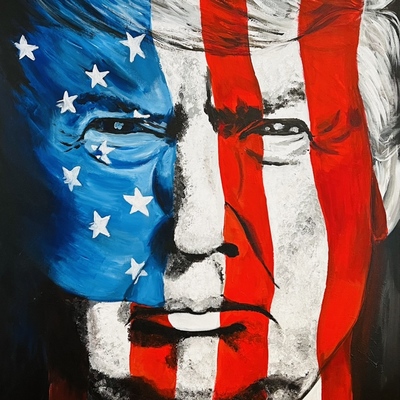Stay informed on the latest Truth Social posts from Donald Trump (@realDonaldTrump) without the doomscrolling. Consider it a public service for your mental health. (Why?)
- The United States has a significant and persistent trade deficit with Iraq.
- The U.S. will impose a 30% tariff on all Iraqi products starting August 1, 2025.
- The 30% tariff is separate from all sectoral tariffs.
- Goods transshipped to evade a higher tariff will be subject to the 30% tariff.
- The 30% tariff is far less than what is needed to eliminate the trade deficit.
- If Iraq raises its tariffs, the U.S. will add that amount to the 30% charge.
- Iraq's tariffs, non-tariff policies, and trade barriers have caused unsustainable trade deficits against the United States.
- The trade deficit is a major threat to the U.S. economy and national security.
The letter details a significant unilateral tariff policy against Iraq, citing economic and national security threats due to trade deficits. While Iraq's direct trade volume with the U.S. may not individually be a primary driver for the S&P 500, the aggressive and protectionist nature of this policy, especially the threat of escalating tariffs if Iraq retaliates, sets a notable precedent. This could signal a broader, more confrontational trade policy stance from the U.S. government, potentially leading to wider trade disputes with other nations, which would negatively impact globally exposed S&P 500 companies and overall market sentiment.
The letter from the White House to Iraq's Prime Minister issues a strong economic ultimatum regarding trade policies. The explicit justification of the trade deficit as a threat to U.S. National Security, coupled with the warning of escalating tariffs if Iraq retaliates, significantly increases bilateral tension. This aggressive stance, while not directly involving military action, poses a substantial risk to diplomatic relations and could provoke retaliatory economic measures, elevating the potential for trade conflict.
- Commodities: Gold (XAU) is likely to rise due to increased geopolitical and trade uncertainty. Oil (WTI) prices may experience an upward pressure if markets perceive increased instability in an oil-producing region, even if the direct U.S.-Iraq trade impact on oil is limited. Silver or Copper may react to industrial sentiment if broader trade tensions dampen global growth outlooks. Short-Term Watchlist: XAU/USD price action, headlines on U.S.-Iraq relations. Medium-Term Focus: Inflation trends, Fed policy, global trade outlook, USD trajectory.
- Currencies (Forex): The US Dollar Index (DXY) could see increased volatility. A flight to safety might initially strengthen the USD, but concerns over potential global trade wars and their impact on U.S. economic growth could eventually weaken it. Watch pairs like USDJPY and EURUSD for risk-off flows. Short-Term Watchlist: Treasury yields, global risk sentiment. Medium-Term Focus: Central bank divergence (Fed vs ECB/BoJ), global growth differentials, dollar liquidity cycles.
- Global Equities: S&P 500, Nasdaq, STOXX 600, Nikkei 225, and Hang Seng may experience a negative sentiment shift, particularly for companies with significant international trade exposure, if the policy indicates a broader U.S. protectionist stance. Sectors reliant on global supply chains could be negatively impacted. Short-Term Watchlist: Futures open, VIX spike/dip, sectors sensitive to trade policy. Medium-Term Focus: Earnings revisions, macro data (ISM, PMI), global capital flows, geopolitical overhangs.
- Fixed Income (Bonds): US 10Y and 2Y yields could fall as investors seek safe-haven assets, leading to a flight to quality. Credit spreads may widen if the aggressive trade stance is perceived as a risk to global economic stability. Short-Term Watchlist: UST 10Y yield levels, TED spread, credit ETF flows (e.g., HYG). Medium-Term Focus: Fed dot plots, fiscal concerns, debt ceiling rhetoric, economic surprise indices.
- Volatility / Derivatives: The VIX is likely to spike in response to heightened trade tensions and policy uncertainty emanating from the U.S.'s assertive stance. Options positioning may amplify market moves. Short-Term Watchlist: VIX levels vs VIX futures term structure, 0DTE flow. Medium-Term Focus: Volatility regime shifts, macro policy uncertainty, systemic tail risk.
- Crypto / Digital Assets: Bitcoin (BTC) may initially behave as a risk-on asset, showing correlation with tech stocks and potentially experiencing a downturn if broader market sentiment deteriorates. Alternatively, if trade tensions escalate significantly, some might view BTC as a hedge against traditional financial system instability. Short-Term Watchlist: BTC/USD, Coinbase order book activity, funding rates. Medium-Term Focus: Regulatory news, stablecoin flows, macro liquidity backdrop.
- Cross-Asset Correlations and Systemic Risk: Markets could exhibit a breakdown in normal correlations, with equities and bonds selling off together in a general risk-off environment. Signs of margin calls or liquidity stress should be monitored. Short-Term Watchlist: MOVE index, junk bond ETFs, gold/USD co-movement. Medium-Term Focus: Shadow banking risk, central bank intervention, market plumbing stress.
- Retail Sentiment / Market Psychology: While unlikely to trigger significant direct retail speculation in specific assets immediately, the assertive trade policy could contribute to a broader atmosphere of economic uncertainty among retail investors. Short-Term Watchlist: Broader social media sentiment indicators for economic outlook. Medium-Term Focus: Social media influence on market structure, potential for coordinated retail pushes, policy/regulatory crackdown on retail trading behavior.

